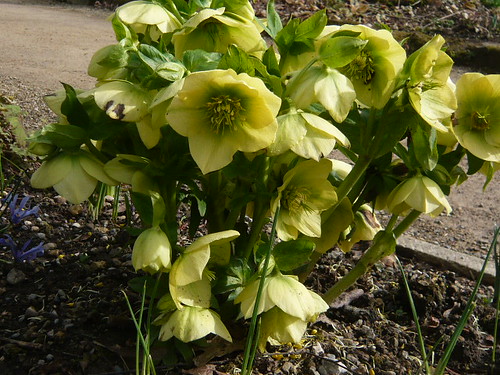Cure Hellebore Problems
Hellebore sap can cause irritation to skin or an allergic reaction. No part of the plant should be eaten.

Hellebores flower in winter or early spring from buds formed during the previous summer. They may benefit from some watering during a dry summer to encourage more buds.
Healthy Hellebores growing in well ventilated, damp but not waterlogged environments should not show any blackening on actively growing tissue.
Mosaic viruses known as ‘Hellebore black death’ is similar to tomato and cucumber mosaic viruses. Spots or streaks appear on the leaves and plants are stunted or die. There is no garden cure so dig up the plants and burn them – do not compost.
Hellebore leaf spot is caused by a fungus Coniothyrium hellebori. The hellebore gets irregular brown or black spots on the leaves and sometimes the flowers. This causes leaves to yellow and flowers to wilt. Buds often fail to open on infected plants
Cures for Hellebore Leaf Spot
- Pick off affected leaves and burn or bin them. Do not compost.
- Fungicides may provide some control. Try Systhane Fungus fighter or Bayer Fungus Fighter Disease Control
Hellebore are susceptible to root decay caused by Phytophthora. This is a fungus that thrives in waterlogged soils. The only cure is to improve drainage. The fungus can remain in the soil for many years so do not replant in the same area.
Snails have to be very hungry to take on the old Hellebore leaves but young shoots may be nibbled. Insects seem to leave Hellebores alone but it may be worth spraying for greenfly as they are virus carriers. Vine weevil can be a problem on a small scale.
Always buy clean healthy stock from reputable suppliers.
At the first sign of trouble root it out!
Avoid Hellebore Hell by treating plants to cure Hellebore problems
Hellebores: A Comprehensive Guide from Amazon

Helleborus orientalis
- Helleborus orientalis is the parent of many of the popular hybrids.
- It originates from scrub, woodlands and the sides of paths in limey areas.
- Plants prefer shade but will grow in sun given enough moisture.
- Mature plants seed freely and are quite long lived.
- Native to woodlands of Greece and Turkey


One thought on “Cure Hellebore Problems”
Comments are closed.